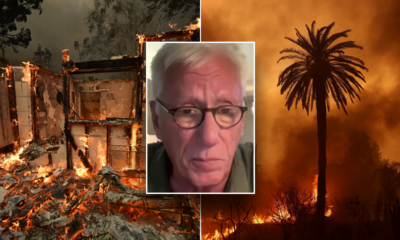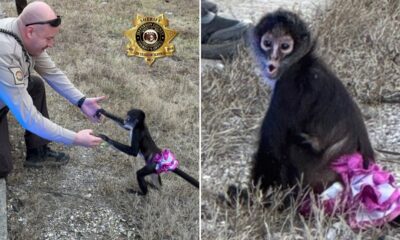Wyoming
Pleasant and warm Sunday

CHEYENNE, Wyo. (Wyoming News Now) – Most locations were dry for Saturday, but looking a little warmer as we head into Sunday.
Heading into tonight, while some lingering clouds are possible early we clear out pretty quick. Low temperatures into the 40s and 50s around our region. Folks in far western Wyoming and into the mountains will be into the 30s tonight.
As we kick off Sunday, folks mainly in central to west central Wyoming (Douglas, Casper, Riverton to Jackson) may experience a haze. Westerly flow will allow for some smoke from the Fish Creek fire to move into the area. This may degrade air quality at times, especially in the Wind River to Teton Mountains.

Other than some smoke in the skies, we will see some sunshine and a few afternoon clouds. A stay shower or storm is not out of the question, especially in southeast Wyoming and northern portions of Colorado. High temperatures into the 80s and 90s. Temperatures in the 70s west of the Continental Divide.

Extended Forecast for Cheyenne – Sun and clouds through Sunday. A stray shower is possible during the afternoon. Overall looks dry for much of the work week. Warm start to the week, with some cooling temperatures by the end of the week.

Extended Forecast for Casper – Sunny, dry, and warm start to the work week. We do see a drop in temperatures heading into the end of the week, with highs by Friday in the low 70s.

Copyright 2024 KGWN. All rights reserved.

Wyoming
Wyoming Legislature to Convene 2025 General Session Tuesday

The 68th Wyoming Legislature will convene for the 2025 General Session on Tuesday at Noon. The bodies will hold opening ceremonies as their first order of business, and newly elected members of the Legislature and legislative leadership will be sworn in. Following a brief recess, the bodies will begin introduction and referral of bills Tuesday afternoon. All floor proceedings and committee meetings during the 2025 General Session will be broadcast live via the Legislature’s YouTube channel.
The Legislature will then convene in a joint session of the Wyoming Senate and House of Representatives on Wednesday at 10 am, during the second day of legislative proceedings. At that time, Gov. Mark Gordon will deliver his State of the State message, followed by the State of the Judiciary message, delivered by Wyoming Supreme Court Chief Justice Kate M. Fox in the House Chamber at the Wyoming State Capitol.
Wyoming
230 Million-Year-Old Fossil From Wyoming Challenges Dinosaur Origin Theories

Though paleontologists have been discussing the origin and spread of dinosaurs for decades, the widely accepted theory was that they emerged in the southern part of the ancient continent of Pangea over 200 million years ago, and only spread northward millions of years later. A new study dramatically changes the conversation.
University of Wisconsin–Madison (UW–Madison) paleontologists announced the discovery of a new dinosaur that challenges the conventional theory about the dinosaurs’ origin and spread. The location and age of the newly-described fossils suggest that dinosaurs prowled the northern regions of Pangea millions of years earlier than previously hypothesized. The findings were detailed in a January 8 study published in the Zoological Journal of the Linnean Society.
“We’re kind of filling in some of this story, and we’re showing that the ideas that we’ve held for so long — ideas that were supported by the fragmented evidence that we had — weren’t quite right,” Dave Lovelace of the University of Wisconsin Geology Museum, who co-led the study, said in a UW–Madison statement. “We now have this piece of evidence that shows dinosaurs were here in the northern hemisphere much earlier than we thought.”
The paleontologists uncovered the theory-defying fossils in present-day Wyoming in 2013. Due to Earth’s shifting tectonic plates, this region was located near the equator over 200 million years ago on Laurasia, the northern half of Pangea (the southern half was called Gondwana). While the remains were fragmented, the paleontologists were able to attribute the fossils to a new dinosaur species they named Ahvaytum bahndooiveche, which was likely an early sauropod relative. Ahvaytum, however, looked very different from the iconic long-necked herbivores.
“It was basically the size of a chicken but with a really long tail,” said Lovelace. “We think of dinosaurs as these giant behemoths, but they didn’t start out that way.” The adult specimen was just over a foot tall (30.5 centimeters) and about three feet long (91.4 cm).
Perhaps most shockingly, however, is the age of the fossil. Lovelace and his colleagues used radioisotopic dating (a method for determining the age of materials by measuring radioactive decay) to determine that the rock layers where they’d found the Ahvaytum fossils—and thus roughly the remains themselves—were about 230 million years old. This makes Ahvaytum the oldest known Laurasian dinosaur, and about equivalent in age to the earliest known Gondwanan dinosaurs, according to the study. Dinosaurs first emerged during the Triassic period, around 230 million years ago. This era, which lasted from about 252 to 201 million years ago, saw the rise of the earliest dinos, before they became dominant in the Jurassic period.
“We have, with these fossils, the oldest equatorial dinosaur in the world — it’s also North America’s oldest dinosaur,” Lovelace added. The fact that the oldest known Laurasian dinosaur is about as old as the earliest known Gondwanan dinosaurs consequently challenges the theory that dinosaurs originated in the south of the ancient continent and only spread north millions of years later.
The site of the discovery is within the ancestral lands of the Eastern Shoshone Tribe. As a result, the researchers partnered with tribal members throughout their work, and included Eastern Shoshone elders and middle school students in choosing the new dinosaur’s name. Ahvaytum bahndooiveche roughly translates to “long ago dinosaur” in the Eastern Shoshone language.
The region also yielded additional finds. The team identified an early dinosaur-like footprint in older rock layers, meaning that dinosaurs or dinosaur-related creatures were calling Laurasia home even before Ahvaytum. The paleontologists also uncovered the fossil of a newly described amphibian, which was also named in the Eastern Shoshone language.
In challenging long-standing theories about how dinosaurs spread across Pangea, the discovery of the chicken-sized Ahvaytum ultimately paints a clearer picture of the creatures that walked the Earth—and where—millions of years before us.
Wyoming
Lobos come alive in second half to put away Wyoming
-

 Business1 week ago
Business1 week agoThese are the top 7 issues facing the struggling restaurant industry in 2025
-

 Culture1 week ago
Culture1 week agoThe 25 worst losses in college football history, including Baylor’s 2024 entry at Colorado
-

 Sports1 week ago
Sports1 week agoThe top out-of-contract players available as free transfers: Kimmich, De Bruyne, Van Dijk…
-

 Politics6 days ago
Politics6 days agoNew Orleans attacker had 'remote detonator' for explosives in French Quarter, Biden says
-

 Politics6 days ago
Politics6 days agoCarter's judicial picks reshaped the federal bench across the country
-

 Politics5 days ago
Politics5 days agoWho Are the Recipients of the Presidential Medal of Freedom?
-

 Health4 days ago
Health4 days agoOzempic ‘microdosing’ is the new weight-loss trend: Should you try it?
-

 World1 week ago
World1 week agoIvory Coast says French troops to leave country after decades



















